How to replace the drive motor in a top-load washer
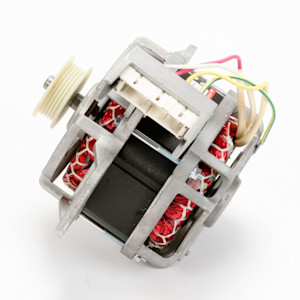
This washer repair guide gives step-by-step instructions for replacing the drive motor in a common type of top-load washer. During the agitate and spin cycles, the drive motor rotates a belt attached to the drive system pulley. The pulley transfers the rotation to the spin basket and agitator. If the motor doesn’t rotate, replace it with a manufacturer-approved washer part.
This repair procedure covers belt-drive, top-load washers made by Kenmore, Whirlpool, Maytag and Amana.
We also have instructions for replacing the drive motor in a direct-drive front-load washer. If you're not sure if your washer has a direct-drive motor, check out the explanation in our washer FAQs.
This video shows how to replace the drive motor in a top-load washing machine.
Instructions
- 01.
Shut off the electricity and water
Unplug the power cord from the wall outlet.
Turn off the water supply valves for the washer.
Wear work gloves to protect your hands.
Have someone help you move the washer away from the wall.
- 02.
Disconnect the hoses
Mark which fill hose goes to the hot connector and which goes to the cold.
Using channel lock pliers, carefully loosen and remove both fill hoses. Expect some water to pour out.
Pull the drain hose out of the standpipe behind the washer. Expect some water to pour out.
Tip: Wipe up water spills with a towel to prevent slipping.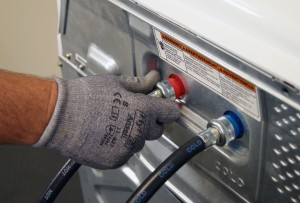
PHOTO: Disconnect the hoses from the back of the washer.
- 03.
Carefully lay the washer on its front panel
Move the washer to an area where you can work on it.
Lay cardboard or towels in front of the washer to prevent scratching the front of the washer.
Carefully tilt the washer forward and lay it on the front panel so that you can access the drain pump from the bottom of the washer.

PHOTO: Lay the washer down on its front panel.
- 04.
Remove the motor
Remove the bolts that secure the plastic cover over the motor and drive components.
Pull the plastic cover off the washer and set it aside.
Pull the drive belt outward and rotate the large drive pulley to work the belt off the motor.
Remove the drive belt and set it aside. Remove the bolts that secure the drive motor to the bottom of the washer.
Remove the motor.
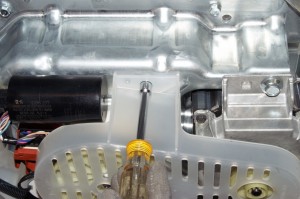
PHOTO: Remove the bolts holding the plastic cover over the motor.
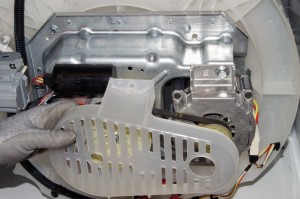
PHOTO: Remove the plastic motor cover.
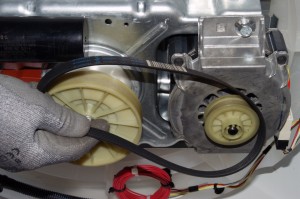
PHOTO: Remove the drive belt.
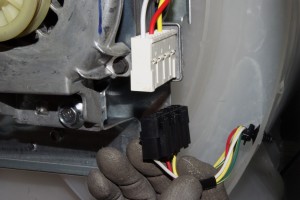
PHOTO: Disconnect the motor wires.

PHOTO: Remove the drive motor mounting bolts.
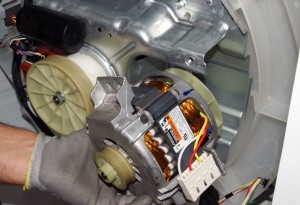
PHOTO: Remove the drive motor.
- 05.
Install the new motor
Position the new drive motor in place and install the mounting bolts.
Tighten the mounting bolts firmly.
Plug the wire harness into the connection on the new drive motor. Make sure that the wire harness plug is firmly seated in the connection on the motor.
Position the drive belt properly on the smaller motor pulley and stretch the belt across the top of the larger drive pulley.
Start on one side of the pulley and roll the belt onto the drive pulley by rotating the drive pulley as you push the belt down onto the side of the drive pulley.
Position the plastic cover on top of the motor and drive components.
Line up the mounting holes and insert the mounting bolts.
Tighten the bolts firmly.
- 06.
Set the washer upright
Carefully set the washer upright and move it close enough to the fill hoses that you can reconnect them.
- 07.
Reinstall the fill hoses
Thread the fill hoses onto the connections on the back of the washer.
Tighten the connections firmly using a pair of channel lock pliers.
- 08.
Restore the water and power
Turn on the water supply valves.
Tighten the connection if you find a slight leak.
Plug the washer into the electrical outlet.
Return the washer to its original location.
Most common symptoms to help you fix your washers
Choose a symptom to see related washer repairs.
Main causes: clogged drain hose, house drain clogged, bad drain pump, water-level pressure switch failure, bad control b…
Main causes: worn agitator dogs, bad clutch, broken motor coupler, shifter assembly failure, broken door lock, suspensio…
Main causes: bad lid switch or door lock, bad timer or electronic control board, wiring failure, bad water inlet valve a…
Main causes: broken lid switch or lid lock, bad pressure switch, broken shifter assembly, faulty control system…
Main causes: unbalanced load, loose spanner nut, worn drive block, broken shock absorber or suspension spring, debris in…
Main causes: no water supply, bad water valves, water-level pressure switch failure, control system failure, bad door lo…
Main causes: lack of electrical power, wiring failure, bad power cord, electronic control board failure, bad user interf…
Main causes: leaky water inlet valve, faulty water-level pressure switch, bad electronic control board…
Main causes: water heater failure, bad water temperature switch, faulty control board, bad water valve, faulty water tem…
Repair guides for top-load washers
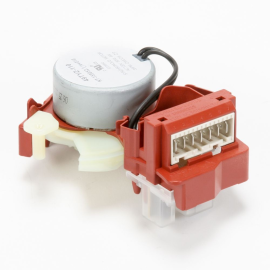
How to replace the shifter assembly in a top-load washer
The shifter motor switches the washer's drive motor between the agitate and spin modes. If your washer's basket won't bu…
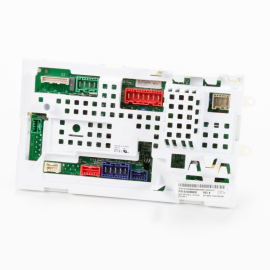
How to replace the electronic control board on a top-load washer
The electronic control board is a major component that orchestrates the washer's functions. These instructions explain h…
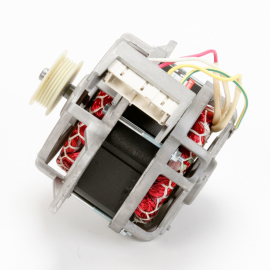
How to replace the drive motor in a top-load washer
The drive motor creates the rotation that turns the spin basket and agitator. If those components won't budge, replace t…
Effective articles & videos to help repair your washers
Use the advice and tips in these articles and videos to get the most out of your washer.
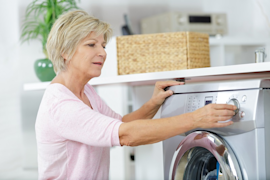
Find tips for using your washing machine efficiently to save energy and help reduce utility bills.…

Learn about all the convenient features on our Sears PartsDirect website that make your parts purchases easier.…

Get answers to frequently asked questions about Sears and Sears PartsDirect.…
